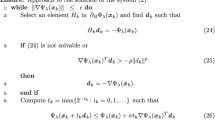Abstract
This paper describes a damped-Newton method for solving the nonlinear complementarity problem when it is formulated as a system of B-differentiable equations through the use of the Minty-map. This general Newton algorithm contains a one-dimensional line search and possesses a global convergence property under certain conditions; modifications and heuristic implementations of the algorithm for the case when these conditions do not hold are also discussed. The numerical experiments show that, in general, this new scheme is more efficient and robust than the traditional Josephy-Newton algorithm.
Similar content being viewed by others
References
D.P. Bertsekas and E.M. Gafni, “Projection methods for variational inequalities with application to the traffic assignment problem,”Mathematical Programming Study 17 (1982) 139–159.
J.E. Dennis Jr. and R.B. Schnabel,Numerical Methods for Unconstrained Optimization and Nonlinear Equations (Prentice-Hall, Englewood Cliffs, NJ, 1983).
G.J. Habetler and M.M. Kostreva, “On a direct algorithm for nonlinear complementarity problems,”SIAM Journal of Control and Optimization 16 (1978) 504–511.
P.T. Harker, “Alternative models of spatial competition,”Operations Research 34 (1986) 410–425.
P.T. Harker, “Accelerating the convergence of the diagonalization and projection algorithms for finite-dimensional variational inequalities,”Mathematical Programming 41 (1988) 29–59.
P.T. Harker and J.S. Pang, “Finite dimensional variational inequality and nonlinear complementarity problems: a survey of theory, algorithms and applications,”Mathematical Programming B 48 (1990) 1–60.
P.T. Harker and J.S. Pang, “A damped-Newton method for the linear complementarity problem,” in: G. Allgower and K. Gears, eds.,Computational Solutions of Nonlinear Systems of Equations, Lectures in Applied Mathematics, Vol. 26 (American Mathematical Society, Providence, RI, 1990) 265–284.
N.H. Josephy, “Newton's method for generalized equations,” Technical summary report No. 1965, Mathematics Research Center, University of Wisconsin (Madison, Wisconsin, 1979).
N.H Josephy, “Quasi-Newton method for generalized equations,” Technical Summary Report No. 1966, Mathematics Research Center, University of Wisconsin (Medison, WI, 1979).
M. Kojima and S. Shindo, “Extension of Newton and quasi-Newton methods to systems of PC equations,”Journal of the Operations Research Society of Japan 29 (1986) 352–374.
M. Kojima, S. Mizuno and A. Yoshise, “A polynomial-time algorithm for a class of linear complementarity problems,”Mathematical Programming 44 (1989) 1–26.
M. Kojima, S. Mizuno and T. Name, “A new continuation method for complementarity problems with uniform P-functions,”Mathematical Programming 43 (1989) 107–113.
M. Kojima, S. Mizuno and T. Nome, “Limiting behavior of trajectories generated by a continuation method for monotone complementarity problems,” Report No. B-199, Department of Information Sciences, Tokyo Institute of Technology (Tokyo, Japan, 1988).
M.M. Kostreva, “Direct algorithms for complementarity problems,” unpublished Ph.D. Dissertation, Department of Mathematics, Rensselaer Polytechnic Institute (Troy, NY, 1976).
M.M. Kostreva, “Block pivot methods for solving the complementarity problem,”Linear Algebra and its Applications 21 (1978) 207–215.
O.L. Mangasarian, “Equivalence of the complementarity problem to a system of nonlinear equations,”SIAM Journal on Applied Mathematics 31 (1976) 89–92.
L. Mathiesen, “Computation of economic equilibria by a sequence of linear complementarity problems,”Mathematical Programming Study 23 (1985) 144–162.
L. Mathiesen, “Computational experience in solving equilibrium models by a sequence of linear complementarity problems,”Operations Research 33 (1985) 1225–1250.
L. Mathiesen, “An algorithm based on a sequence of linear complementarity problems applied to a Walrasian equilibrium model: an example,”Mathematical Programming 37 (1987) 1–18.
K.G. Murty, “Note on a Bard-type scheme for solving the complementarity problem,”Opsearch 11 (1974) 123–130.
K.G. Murty,Linear Complementarity, Linear and Nonlinear Programming (Helderman, Berlin, 1988).
J.M. Ortega and W.C. Rheinboldt,Iterative Solution of Nonlinear Equations in Several Variables (Academic Press, New York, 1970).
J.S. Pang and D. Chan, “Iterative methods for variational and complementarity problems,”Mathematical Programming 24 (1982) 284–313.
J.S. Pang, “Inexact Newton methods for the nonlinear complementarity problem,”Mathematical Programming 36 (1986) 54–71.
J.S. Pang, “Newton's method for B-differentiable equations,”Mathematics of Operations Research, forthcoming.
M.J.D. Powell, “A method for nonlinear constraints in minimization problems,” in: R. Fletcher, ed.,Optimization (Academic Press, New York, 1969).
P.V. Preckel, “A modified Newton method for the nonlinear complementarity problem,” Paper presented at the ORSA/TIMS Joint National Meeting, Miami Beach, Florida, October 1986.
S.M. Robinson, “Implicit B-differentiability in generalized equations,” Technical Summary Report No. 2854, Mathematics Research Center, University of Wisconsin (Madison, WI, 1985).
S.M. Robinson, “Local structure of feasible sets in nonlinear programming, Part III: stability and sensitivity,”Mathematical Programming Study 30 (1987) 45–66.
S.M. Robinson, “An implicit function theorem for B-differentiable functions,” Working Paper, Department of Industrial Engineering, University of Wisconsin (Madison, WI, 1988).
S.M. Robinson, “Newton's method for a class of nonsmooth functions,” Working Paper, Department of Industrial Engineering, University of Wisconsin (Madison, WI, 1988).
R.T. Rockafellar, “Monotone operators and the proximal point algorithm,”SIAM Journal on Control and Optimization 14 (1976) 877–898.
H. Scarf,The Computation of Economic Equilibria, (Yale University Press, New Haven, CT, 1973).
A. Shapiro, “On concepts of directional differentiability,” Research Report 73/88(18), Department of Mathematics and Applied Mathematics, University of South Africa (Pretoria, South Africa, 1988).
P.K. Subramanian, “Gauss-Newton methods for the nonlinear complementarity problem,” Technical Summary Report No. 2845, Mathematics Research Center, University of Wisconsin (Madison, WI, 1985).
P.K. Subramanian, “A note on the least two norm solutions of monotone complementarity problems,”Applied Mathematics Letters 1 (1988) 395–397.
R.L. Tobin, “A variable dimension solution approach for the general spatial price equilibrium problem,”Mathematical Programming 40 (1988) 33–51.
Author information
Authors and Affiliations
Rights and permissions
About this article
Cite this article
Harker, P.T., Xiao, B. Newton's method for the nonlinear complementarity problem: A B-differentiable equation approach. Mathematical Programming 48, 339–357 (1990). https://doi.org/10.1007/BF01582262
Received:
Revised:
Issue Date:
DOI: https://doi.org/10.1007/BF01582262



